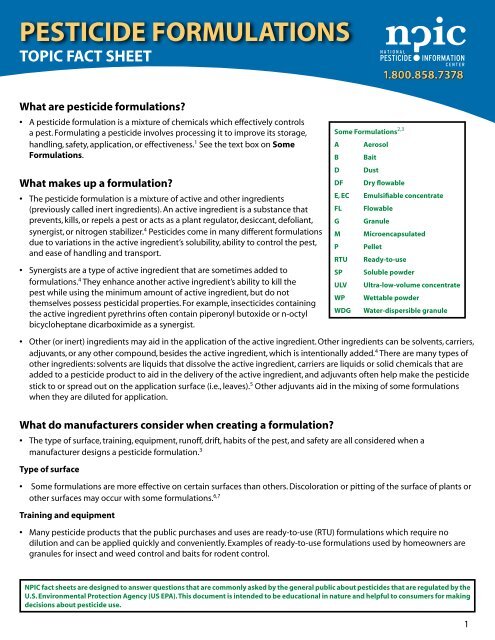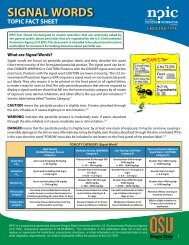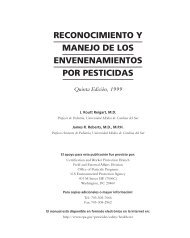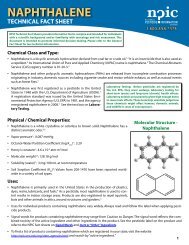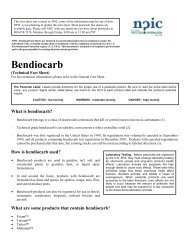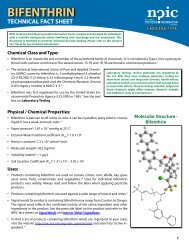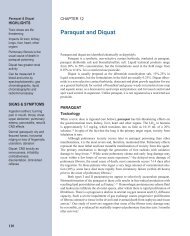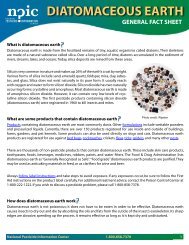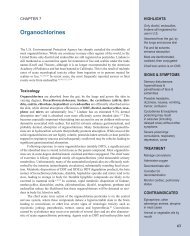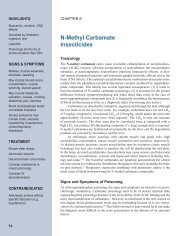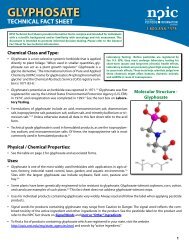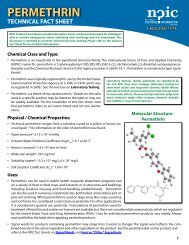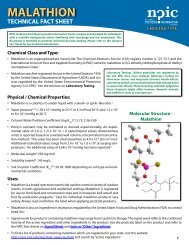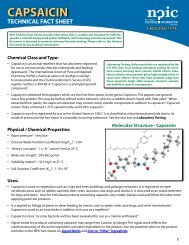Pesticide Formulations - National Pesticide Information Center ...
Pesticide Formulations - National Pesticide Information Center ...
Pesticide Formulations - National Pesticide Information Center ...
You also want an ePaper? Increase the reach of your titles
YUMPU automatically turns print PDFs into web optimized ePapers that Google loves.
PESTICIDE FORMULATIONSTOPIC FACT SHEETWhat are pesticide formulations?•• A pesticide formulation is a mixture of chemicals which effectively controlsa pest. Formulating a pesticide involves processing it to improve its storage,handling, safety, application, or effectiveness. 1 See the text box on Some<strong>Formulations</strong>.What makes up a formulation?•• The pesticide formulation is a mixture of active and other ingredients(previously called inert ingredients). An active ingredient is a substance thatprevents, kills, or repels a pest or acts as a plant regulator, desiccant, defoliant,synergist, or nitrogen stabilizer. 4 <strong>Pesticide</strong>s come in many different formulationsdue to variations in the active ingredient’s solubility, ability to control the pest,and ease of handling and transport.•• Synergists are a type of active ingredient that are sometimes added toformulations. 4 They enhance another active ingredient’s ability to kill thepest while using the minimum amount of active ingredient, but do notthemselves possess pesticidal properties. For example, insecticides containingthe active ingredient pyrethrins often contain piperonyl butoxide or n-octylbicycloheptane dicarboximide as a synergist.Some <strong>Formulations</strong> 2,3A AerosolB BaitD DustDF Dry flowableE, EC Emulsifiable concentrateFL FlowableG GranuleM MicroencapsulatedP PelletRTU Ready-to-useSP Soluble powderULV Ultra-low-volume concentrateWP Wettable powderWDG Water-dispersible granule•• Other (or inert) ingredients may aid in the application of the active ingredient. Other ingredients can be solvents, carriers,adjuvants, or any other compound, besides the active ingredient, which is intentionally added. 4 There are many types ofother ingredients: solvents are liquids that dissolve the active ingredient, carriers are liquids or solid chemicals that areadded to a pesticide product to aid in the delivery of the active ingredient, and adjuvants often help make the pesticidestick to or spread out on the application surface (i.e., leaves). 5 Other adjuvants aid in the mixing of some formulationswhen they are diluted for application.What do manufacturers consider when creating a formulation?•• The type of surface, training, equipment, runoff, drift, habits of the pest, and safety are all considered when amanufacturer designs a pesticide formulation. 3Type of surface••Some formulations are more effective on certain surfaces than others. Discoloration or pitting of the surface of plants orother surfaces may occur with some formulations. 6,7Training and equipment•• Many pesticide products that the public purchases and uses are ready-to-use (RTU) formulations which require nodilution and can be applied quickly and conveniently. Examples of ready-to-use formulations used by homeowners aregranules for insect and weed control and baits for rodent control.NPIC fact sheets are designed to answer questions that are commonly asked by the general public about pesticides that are regulated by theU.S. Environmental Protection Agency (US EPA). This document is intended to be educational in nature and helpful to consumers for makingdecisions about pesticide use.1
PESTICIDE FORMULATIONSTOPIC FACT SHEET•• Many of the formulations used by farmers and commercial applicators (like pest control companies) need to be appliedwith certain equipment. These formulations may also require certification or training for individuals performing theapplication. For example, termiticide applicators may be required by the Department of Agriculture in each state tocomplete specific training in the use of termiticides.•• Some liquid pesticide formulations commonly used by farmers and commercial applicators are applied with acompressed air sprayer, fogger, or soil injector. 6 Other liquid pesticide formulations used by farmers may require the useof aircraft, low pressure boom sprayer, high-pressure sprayer, or ultra-low-volume sprayer. 6••The equipment required for the application is listed on the label.Runoff or drift7••Rain soon after the application may cause the pesticide to run off and contaminate lakes, rivers, streams, or ponds.••••Wind may carry or drift the pesticide during the application onto adjacent property, bodies of water, people, or animals.Specific environmental precautionary statements may be present on the label describing how to avoid runoff or drift.Safety to people, animals, and the environment•• Individuals who apply, handle, transport, or dispose of pesticides should know the proper manner in which to deal withthem. Safety gear is important to minimize potential exposure to pesticides during an application. An applicator’s properpersonal protective equipment (PPE) may include a long sleeve shirt, pants, closed-toe shoes, chemically resistant rubbergloves, a respirator, and/or eye protection. The equipment required for an application will be listed on the label.•• In addition to the safety of those working with pesticides, the safety of people, pets, and the environment near the siteof application need to be taken into account. 7 To facilitate this, the label often has precautionary statements to protectwildlife and other non-target species.Habits of the pest•• The pest needs to be identified. <strong>Information</strong> on how the pest feeds, its reproductive habits, and its life cycle will help themanufacturer determine which formulation would be the most effective. 7Can pesticides be mixed together?•• The pesticide product label will list any chemicals that it should not be mixed with (i.e., incompatible with) or containersthat it should not be mixed in.4 For example, wettable sulfur should not be mixed with Lorsban or Morestan becausethey are incompatible. 6••••Some pesticides can be mixed together (i.e., they are compativle with each other).Not all pesticides can be mixed together (incompatible) because they separate out of the solution, gel, curdle, or clog theequipment during application.•• <strong>Pesticide</strong>s that are physically different (i.e., dust versus liquid) are typically incompatible.2For more information contact: NPICOregon State University, 310 Weniger Hall, Corvallis, OR 97331-6502Phone: 1-800-858-7378 Fax: 1-541-737-0761Email: npic@ace.orst.edu Web: npic.orst.edu
PESTICIDE FORMULATIONSTOPIC FACT SHEETHow are incompatibilities avoided?•• Verify with the pesticide label what types of pesticide formulations to avoid mixing. Formulated pesticide products thatare ready-to-use (RTU) liquids and concentrated liquids that have been diluted according to label instructions can bemixed together. However, undiluted liquid concentrations should not be combined.••To reduce incompatibilities of flowable, wettable powder, and water-dispersible granule formulations, regular shaking isneeded. 2•• If you have questions about compatibility or other pesticide-related issues contact your State Department of Agricultureor your local County Cooperative Extension Service for more information.Date Reviewed: December 1999References1. Ware, G.W. The <strong>Pesticide</strong> Book, 4th ed; W.H. Freeman: Fresno, CA, 1994.2. University of Nebraska Cooperative Extension Service. A guide for private and commercial applicators. Applying pesticidescorrectly. <strong>National</strong> pesticide applicator training core manual, University of Nebraska: Lincoln, 1992.3. Oregon <strong>Pesticide</strong> Applicator’s Manual: a guide to the safe use and handling of pesticides; Miller, T.L, ed. Oregon StateUniversity Extension Service: Corvallis, 1993.4. Label Review Manual; U.S. Environmental Protection Agency, Office of <strong>Pesticide</strong> Programs, U.S. Government PrintingOffice: Washington, DC, 1998. http://www.epa.gov/oppfead1/labeling/lrm5. Terms of the Environment; U.S. Environmental Protection Agency, Office of <strong>Pesticide</strong> Programs, U.S. Government PrintingOffice: Washington, DC, 1997. http://www.epa.gov/OCEPAterms/6. Bohmont, B.L. The standard pesticide user’s guide (revised). Prentice Hall: Princeton, NJ, 1990.7. Farm Chemicals Handbook 1997; Meister Publishing Company, Willoughby, OH, 1997.NPIC is a cooperative agreement between Oregon State University and the U.S. Environmental Protection Agency(U.S. EPA, cooperative agreement # X8-83458501). The information in this publication does not in any wayreplace or supercede the restrictions, precautions, directions, or other information on the pesticide label or anyother regulatory requirements, nor does it necessarily reflect the position of the U.S. EPA.3


